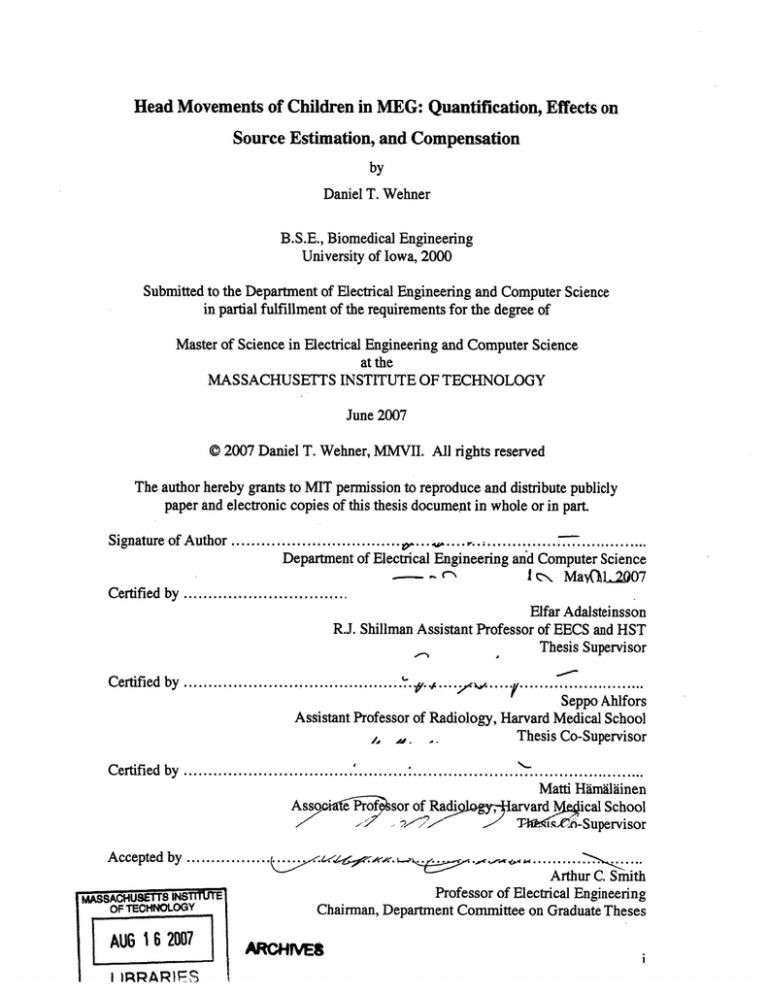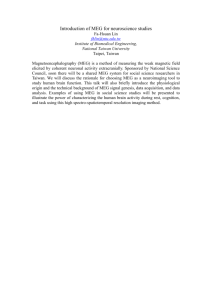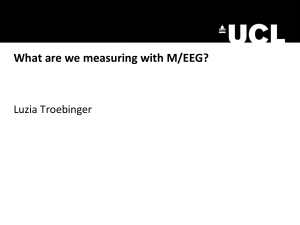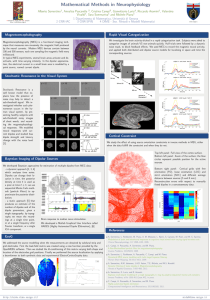
Head Movements of Children in MEG: Quantification, Effects on
Source Estimation, and Compensation
by
Daniel T. Wehner
B.S.E., Biomedical Engineering
University of Iowa, 2000
Submitted to the Department of Electrical Engineering and Computer Science
in partial fulfillment of the requirements for the degree of
Master of Science in Electrical Engineering and Computer Science
at the
MASSACHUSETTS INSTITUTE OF TECHNOLOGY
June 2007
© 2007 Daniel T. Wehner, MMVII. All rights reserved
The author hereby grants to MIT permission to reproduce and distribute publicly
paper and electronic copies of this thesis document in whole or in part.
Signature of Author
.....................
.............
Department of Electrical Engineering and Computer Science
.
Certified by ..........
I
.\
Mav(1L2007
..................
Elfar Adalsteinsson
R.J. Shillman Assistant Professor of EECS and HST
Thesis Supervisor
Certified by ..............................................
. ......
......................
Seppo Ahlfors
Assistant Professor of Radiology, Harvard Medical School
Thesis Co-Supervisor
C ertified by ..................................................................
......... .......
Matti HiIrndlinen
Ass
so••of Radijl
2
X 2C
Accepted by ................
.,
arvard Meical School
X <XT-ii
-Supervisor
.-
..... .....
..
Arthur C. Smith
MA•SSACHU:MS INSI-E "Professor
OF TECHNOLOGY
AU[ 162007
LIBRARES
of Electrical Engineering
Chairman, Department Committee on Graduate Theses
BRARCHAR
Head Movements of Children in MEG: Quantification, Effects
on Source Estimation, and Compensation
by
Daniel T. Wehner
Submitted to the Department of Electrical Engineering and Computer Science
on May 11, 2007 in Partial Fulfillment of the
Requirements for the Degree of Master of Science in
Electrical Engineering and Computer Science
Abstract
Head movements during MEG recordings in children may lead to inaccurate
localization of brain activity. In this thesis, we examined the effects of head movements
on source estimation in twenty children performing a simple auditory cognitive task. In
addition, we tested the ability of a recently introduced spherical harmonic expansion
method, signal space separation (SSS), to compensate for the effects of head movements
on two source models: equivalent current dipoles (ECDs) and minimum norm estimates
(MNE). In the majority of subjects, the goodness-of-fit of ECDs fit to the peak of the
auditory N100m response was increased following the SSS correction compared with the
averaged forward solution method proposed earlier. The spatial spread of ECDs as
determined with a bootstrapping approach was also reduced after SSS correction. In
addition, the MNE source estimates were spatially sharpened following SSS application,
indicative of an increase in signal to noise ratio. Together these results suggest that SSS
is an effective method to compensate for head movements in MEG recordings in
children.
Thesis Supervisor 1: Elfar Adalsteinsson, Ph.D.
Title: Assistant Professor of EECS and HST
Thesis Supervisor 2: Seppo Ahlfors, Ph.D.
Title: Assistant Professor of Radiology, Harvard Medical School
Thesis Supervisor 3: Matti Hdmimiliinen, Ph.D.
Title: Associate Professor of Radiology, Harvard Medical School
Acknowledgments
It has been a rather circuitous route that led me to this masters project. With a
background in Biomedical Engineering, I decided six years ago to take a stroll through
the somewhat nebulous world of pediatric cognitive neuroscience. At several points
along the path, interesting branches appeared which could only be navigated via a
merging of technical knowledge and practical experience with conducting imaging
experiments with children. The work in this thesis represents one of those branches, as I
travel back into the familiar land of complex equations, engineering, and physics.
First I would like to thank my triumvirate of supervisors, Seppo Ahlfors, Matti
Hiimilaiinen, and Elfar Adalsteinsson. This project would not have been possible if it
were not for your patience and wisdom that you have provided to me over the past few
years.
I want to thank all of my many coworkers at the Athinoula A. Martinos Center for
Biomedical Imaging. I especially would like to thank Maria Mody, my PhD thesis
supervisor, for helping with various aspects of the project. Surina Basho, Deirdre von
Pechmann and Dan Wakeman have helped out tremendously in assisting with the MEG
recordings.
I would also like to thank all of my colleagues over in Finland who have provided
assistance to this project including Jukka Nenonen and Samu Taulu and everyone else at
Elekta-Neuromag.
To Asa Masaki, thanks for putting up with the late nights and the long weekends that
working on two theses at once yields. Without your continued support and
encouragement, everything in my life would be so much more difficult.
I would also like to thank all the children and parents for their willingness to participate
in the studies in this thesis.
And finally, to my dad...your hard work and dedication to engineering has been an
inspiration to me all of my life. I dedicate this thesis in your honor.
This work has been supported in part by several grants from the NIH (DC00159,
HD056355), the National Center for Research Resources (P41RR14075), and the Mental
Illness and Neuroscience Discovery (MIND) Institute. Additional funding was from an
NIH Training Grant (DC00038) and an NIH Neuroimaging Training Program Fellowship
(5T32EB001680; PI: Bruce Rosen).
List of Figures
2.1 Neurophysiological basis of the MEG signal...............................
..... 4
2.2 The Elekta-Neuromag 306-channel MEG system.............................. ....
6
2.3 Equivalent Current Dipole (ECD) and Minimum Norm Estimate (MNE)
source modeling......................................................
........................................... 7
2.4 Head position within MEG sensor array.................................
...............
3.1 The coordinate system for the MEG measurements.......................................... 13
4.1 Head movement statistics in one child....................................
4.2 Dipole source localization errors...............................
....
.................
23
............... 26
4.3 Event-related magnetic fields for one child ......................... ,,,,,,,,,...................... 28
4.4 Distributed source estimates in one child...................................
..... 30
4.5 SSS compensation and MNE................................................31
Contents
1
2
3
4
Introduction....................................................................................................
1.1
Motivation..........................................................................................
1
1.2
Outline of the thesis ......................................................................
1
1.3
Thesis contributions.........................................................................
2
Background ....................................................................................................
4
2.1
Neurophysiological basis of the MEG signal.................................
4
2.2
MEG data acquisition and analysis .............................................
5.........
2.3
MEG recordings in children...............................................................7........
2.4
Continuous head localization........................................ 9
2.5
Movement compensation...........................................................................
Methods ...........................................................................................................
10
12
3.1
Quantitative assessment of head movement in children......................... 12
3.2
Dipole localization error due to head movements............................
3.3
Movement compensation using the Signal Space Separation method.......16
Results and Discussion ...................................................................................
. 15
22
4.1
Quantitative assessment of head movement in children.........................
22
4.2
Dipole localization error due to head movements............................
24
4.3
Movement compensation using the Signal Space Separation method.......27
4.3.1
Equivalent Current Dipoles...............................................................
4.3.2 Minimum Norm Estimates................................
4.4
5
1
29
............ 30
Discussion............................................................................................ 32
Conclusions.....................................................................................................
34
5.1
Summary ....................................................................................................
34
5.2
Future Work......................................................................................... 35
Bibliography.............................................................................................................
36
1. Introduction
1.1
Motivation
Magnetoencephalography (MEG), as a non-invasive technique to record evoked brain
responses to cognitive processes in adults has been established for some time
(Hmmillidinen, Hari, Ilmoniemi, Knuutila, & Lounasmaa, 1993). In an evoked-response
study, stimuli are presented repeatedly and the data are subsequently averaged over
several trials, time locked to the stimulus. By averaging evoked responses in this
manner, one typically assumes that the position of the head relative to the sensor array
does not change throughout the recording session. However, this assumption is not
necessarily valid, particularly when recording from children. We examined the effects of
head movements on source estimation in twenty children performing a simple auditory
cognitive task. In addition, we tested the ability of a recently introduced spherical
harmonic expansion method, signal space separation (SSS), to compensate for the effect
of these head movements on two source models: equivalent current dipoles (ECDs) and
minimum norm estimates (MNE).
1.2 Outline of the thesis
Chapter 2 presents the relevant background on MEG signals and MEG recording
techniques used with children. This chapter also describes existing methods for
continuous head localization during MEG recordings and discusses previously described
methods to compensate for the effects of head movement in MEG data.
Chapter 3 discusses the methodology that was used to quantify head movement, their
effect on source estimates, and to evaluate the Signal Space Separation (SSS) method to
compensate for these head movements.
Chapter 4 provides the results from the various analyses used in the thesis, and discusses
possible implications of these results.
Chapter 5 includes a general overview of the results, summarizes the contributions of the
thesis, and suggests possibilities for future work.
1.3 Thesis contributions
The experiments designed herein test the hypothesis that SSS is an effective
method of compensating for head movements during recording of MEG data in children.
To test this general hypothesis, we proposed the following aims:
1) Quantify the head motion of children during MEG recordings. Data from head
position indicator (HPI) coils was measured continuously as each subject listened to word
stimuli. From these measured data, the translation and rotation of the subject's head was
calculated every 200 ms and averaged into 10-second bins. The direction with the most
movement was identified in each subject and compared across subjects.
2) Determine the effect of head movements on the accuracy of the estimated location
of equivalent current dipoles (ECD) using simulations as well as auditory evoked
MEG data. We used dipole simulations to estimate the mean, and standard deviation of
dipole localization errors that would have occurred if continuous head position
information was not taken into account in the calculation of the forward solution.
3) Evaluate the effectiveness of SSS for compensating for the effects of head
movements on MEG data in children. We compared the ECD location and goodnessof-fit for auditory N100m evoked responses with and without SSS correction to examine
the effect of SSS on dipole localization. In addition, the impact of SSS on the quality of
the data was quantified using the distributed minimum norm estimation (MNE) source
model. Specifically, we examined the differences between the forward solutions in four
cases using: the initial head position only, an average head position from the beginning of
each run, SSS-correction transforming the data to the head position at the beginning of
each run, and SSS-correction transforming the data to the head position at the beginning
of the experiment. The difference between these cases was evaluated by calculating the
mean MNE amplitude in a small cortical patch surrounding the MEG response at the
peak latency of the N100m for each forward solution condition.
2. Background
2.1 Neurophysiological basis of MEG signal
MEG measures weak magnetic fields (on the order of 10-14 Tesla) arising from
thousands of synchronously active neurons in the brain (Hiimiila"inen et al., 1993; Paetau,
2002; Sato, Balish, & Muratore, 1991). According to Maxwell's equations, a moving
electric charge always generates a magnetic field oriented perpendicularly to the direction
of the movement. The sources of MEG signals are thought to be post-synaptic currents
within the apical dendrites of pyramidal neurons in the cerebral cortex (Fig. 2.1). These
so called primary currents, jP, are oriented perpendicular to the cortical surface. Sources
that are radial, that is oriented perpendicular to the skull surface, do not produce an
appreciable magnetic field outside of the head; The percentage of sources that are strictly
radial is small.
A)
B)
skull
'7
white matter
Figure 2.1: A) The intracellular current, JP, in an apical dendrite of a pyramidal cell
surrounded with a surrounding magnetic field B. B) The externally recorded magnetic
signals arise from the active primary currents (jP) as well as the associated passive
(ohmic) volume currents (j') [Adapted from Paetau, 2002].
2.2 MEG data acquisition and analysis
MEG signals from the brain are much smaller than the magnetic fields
generated by external environmental sources. Hence, MEG measurements are usually
carried out in a magnetically shielded room using sensitive detectors of magnetic flux
called superconducting quantum interference devices (SQUIDs) (Zimmerman, Thiene, &
Harding, 1970). The first MEG measurement of brain activity using a SQUID sensor was
conducted at MIT (Cohen, 1972).
In modern whole-head MEG devices, several hundreds of sensors are
immersed in a liquid helium dewar, which is helmet-shaped and encloses most of the
head (Fig. 2.2A). This arrangement of MEG sensors allows for identification of
simultaneous signals from multiple brain regions. The sensors are typically 3-4 cm from
the cortical surface depending on the subject's head position. Most MEG systems are
designed for use with adults. Hence, the distance between the MEG sensors and the
cortical sources may be further in children with smaller head sizes. Each of the 102
sensor elements in the MEG device used in the present thesis (Fig. 2.2B: squares)
contained one axial magnetometer and two orthogonally-oriented planar gradiometers.
Gradiometers are differential sensors, which maximally detect signals from sources
directly below the sensors, and are generally insensitive to sources far away from the
sensors. In contrast, magnetometers are more sensitive to deep sources than gradiometers
are.
At
A)r
u~
Ki
MI-
**1,
-
Figure 2.2: A) The Elekta-Neuromag
"
306-channel MEG device. B) The scalp surface
for a child is shown within a representation of a helmet-shaped array of MEG sensor
elements (purple squares). The scalp surface is transparent to reveal the estimated brain
activation in the left superior temporal cortex.
MEG experiments are typically designed to examine either spontaneous activity,
e.g., for detection of epileptic spikes, or evoked activity that is time-locked to the
presentation of a stimulus (as in the present thesis). An important goal of MEG data
analysis is to estimate the spatiotemporal distribution of the neural currents giving rise to
the observed MEG signals by solving the 'inverse problem'. The inverse problem is illposed as there are an infinite number of primary (source) current distributions that result
in the same field pattern (Sarvas, 1987). Therefore, the brain sources must be
appropriately modeled and additional constraints must be employed, e.g., obtained from
magnetic resonance imaging (MRI), to eliminate unrealistic solutions. An equivalent
current dipole (ECD) is a good approximation for a small region of activated cortex (Fig.
2.3A). More complicated source configurations can be modeled using multi-dipole
models. Alternatively, a distributed solution such as the minimum norm estimate (MNE)
(Himildinen & Ilmoniemi, 1994), may provide a better approximation of widespread
activation (Fig 2.3B). The location of an ECD or MNE activation can be viewed on a
subject's MRI. Fiducial points on the head are usually digitized at the beginning of the
experiment for alignment of the MEG data with the MRI.
- I
A)
Figure 2.3: A) A magnetic field map for an equivalent current dipole (ECD) source
located in the auditory cortex. B) Minimum norm estimate (MNE) for a distributed
source in the superior temporal cortex.
2.3 MEG recordings in children
One limiting factor affecting the use of MEG in children is the low signal to noise
ratio (SNR). Several factors contribute to the low SNR in children compared to adults;
these include less focused attention during long recording sessions, more frequent eye
movement and blink-related artifacts, and smaller head size (Phillips, 2005). Whereas
the first two can be at least partially mitigated by means of engaging experimental
designs with detailed instructions, extensive training or practice, or with more frequent
rest periods during the recording, smaller head size can only be dealt with by designing
smaller MEG sensor arrays for use with children, or by the development of better signal
processing methods to separate the small MEG signal from the background noise. For
magnetometers and a dipolar current source, the strength of the MEG signal is inversely
proportional to the square of the distance from the source to the sensor: for differential
measures (gradiometers) the fall-off with distance is even faster. For children with small
heads, this is particularly troublesome as the scalp may be several centimeters from some
of the sensors depending on their head position inside of the measurement helmet
containing the sensors (Fig. 2.4), resulting in very weak signals (Marinkovic, Cox, Reid,
& Halgren, 2004). An additional problem with the small head size is that children often
tend to move their heads considerably inside the measurement helmet during the
experiment. This head movement, if not corrected for, leads to loss of spatial details and
inaccurate localization of the brain sources of interest. Although several approaches have
been employed to reduce head movements during MEG experiments, including the use of
foam padding inside the helmet containing the sensors or the use of bite bars, many of
these methods are uncomfortable for children and may result in poor task performance.
However, such measures may not be required if the child's head position is monitored
continuously during the measurement and this information can be used to align the
magnetic fields at each measured time point to a virtual sensor array.
Figure 2.4: Head position within MEG sensor array. The scalp surface for an adult (left)
and a child (right) subject is shown within a representation of a helmet-shaped array of
MEG sensor elements (gray squares).
2.4 Continuous head localization
The relative position of the head with respect to the MEG sensor array can be
determined with the help of three or more small coils that are attached to the head and fed
with continuously oscillating currents during the measurement (Ahlfors & Ilmoniemi,
1989; Fuchs, Wischmann, Wagner, & Kruger, 1995; Incardona, Narici, Modena, & Erne,
1992). By using currents that are outside of the frequency range of the brain activity of
interest, the magnetic field due to the coil currents can be filtered out of the data before
analyzing the brain signals, allowing continuous acquisition of head localization data (de
Munck, Verbunt, Van't Ent, & Van Dijk, 2001; Uutela, Taulu, & Hiimiilainen, 2001;
Wilson, 2004). Typically, the locations of the coils with respect to anatomical landmarks
are determined with a 3D digitizer before the MEG recording. The required coordinate
transform between the anatomy and MEG sensor array is achieved by extracting the coil
signal amplitudes and by using a least-square fit in which each coil is approximated as a
magnetic dipole (Ahlfors & Ilmoniemi, 1989; Fuchs et al., 1995; Incardona et al., 1992).
2.5 Movement compensation
The sequence of the continuous head localization information can be used to
compensate for effects of the head movement on the MEG data. The compensation
effectively results extrapolation of the data to a virtual sensor array, which is fixed with
respect to the subject's head. Two general approaches have been suggested: one is to use
spherical harmonics expansion (Taulu & Kajola, 2004; Wilson, 2004), the other to
construct a distributed source estimate (MNE) from which the measured data can be
extrapolated to a standard representation (Burghoff, Nenonen, Trahms, & Katila, 2000;
de Munck et al., 2001; Hdimildinen & Ilmoniemi, 1994; Numminen, Ahlfors, Ilmoniemi,
Montonen, & Nenonen, 1995). In the latter approach, the calculations can become quite
time consuming since a forward and inverse model needs to be constructed for each head
position. The amount of calculations can be reduced by using series expansions in
spherical harmonics (Taulu & Kajola, 2004; Wilson, 2004). Alternatively, the correction
could be accomplished by averaging the original epochs as usual and by computing an
average forward model over the different head positions (Uutela et al., 2001). In the
signal-space separation (SSS) method the field patterns originating from outside a sphere
encompassing the sensor array are separated from those originating from inside the head.
Thus, SSS is a "hybrid" method of generating virtual channels: it uses spherical
harmonics to obtain field patterns specifically generated by source distributions inside the
head, but without constructing an explicit source estimate.
In this thesis we measured and quantified the head motion of children. We then
examined the effect of this realistic head motion on equivalent current dipole (ECD)
source estimates using simulation. Finally, we evaluated the effectiveness of the SSS
method to compensate for the effect of head movements on ECD and minimum norm
estimates (MNE).
3. Methods
3.1 Quantitative assessment of head movements in children
To assess the amount of head movement in children, we used data from an
investigation of a cognitive task, the results of which are reported elsewhere (Wehner et
al, submitted). Twenty children between 8-12 years of age participated in the study. The
children had no history of neurological or psychological problems, and they had normal
or corrected to normal vision, and normal hearing. All children had English as their
primary language. Written informed assent/consent was obtained from all
subjects/parents in accordance with the Human Subjects Committee at Massachusetts
General Hospital and the Massachusetts Institute of Technology.
A typical protocol for collecting MEG data was used. MEG was recorded using a
306-channel (204 first-order planar gradiometers, 102 magnetometers) whole-head
VectorView MEG system (Elekta-Neuromag Ltd., Helsinki, Finland) in a magnetically
shielded room. Vertical and horizontal electrooculogram (EOG) was recorded for
detection of eye movements and blinks. The locations of anatomical landmarks (nasion
and preauricular points), four head position indicator (HPI) coils, and additional points on
the scalp were digitized for the co-registration of the MEG data with each subject's MRI.
The three anatomical landmarks defined our head-based MEG coordinate system such
that the x-axis passes through the two auricular points with positive direction to the right,
the y-axis is perpendicular to the x-axis and passes through the nasion with positive
direction to the front, and the positive z-axis points up (Fig. 3.1). Continuous MEG
signals were sampled at 601 Hz after filtering from 0.03 to 200 Hz. Responses related to
each stimulus condition were averaged offline using an epoch from -100 to 800 ms with
respect to the stimulus onset. Trials containing eye movements, blinks, or other channel
artifacts (peak-to-peak amplitude >150 pV in EOG or >500 fT/cm in gradiometers) were
rejected. Averaged epochs were low-pass filtered with a cutoff at 40 Hz, and the zero
level in each channel was taken to be the mean value in the 100-ms pre-stimulus baseline.
Figure 3.1: The coordinate system for the MEG measurements.
Auditory evoked MEG data was recorded as subjects performed an oddball
detection task. Subjects were presented with 300 embedded deviant words (bat, cat, rat)
in a train of 1000 standard word (pat) stimuli. The subjects were to press a button if they
detected one of the deviants, and not to press a button otherwise. The experiment was
divided into five four-minute sections or "runs" to give the subjects frequent breaks to
rest. We analyzed the brain responses evoked by the standard word "pat".
While recording MEG, continuous sinusoidal currents were fed to the four HPI
coils positioned on the subject's head. The position and orientation of the head with
respect to the sensor array was computed at 200 ms intervals, using software provided by
the MEG manufacturer. Using these data, the locations of the MEG sensors, originally
given in a coordinate system fixed to the MEG device, were transformed to an
anatomically-based coordinate frame, which was defined by the digitized locations of
fiducial landmarks on the head:
rh= Trd
where rh = [xh
Yh
zh
1]
and
rd =[Xd
(1)
Yd
Zd
1]
are the augmented location
vectors in head-based and device-based coordinate system, respectively, and T is the
rigid body coordinate transformation matrix:
T=
ro]
R is the rotation matrix, and ro = [xo Yo
(2)
zo]T is the associated translation vector. We
computed the mean displacement of the MEG sensors between the beginning of the
experiment and each subsequent time point as
N.,
D(t) = 1
1rh(k)(t) _rhJk)(to)
,
(3)
s k-1
where rhk)(t) is the location of the kth sensor in head coordinates at time t and N, is the
number of sensors. In our case N, = 102, since the Vectorview system has three separate
sensors at the same location, we included only one of the sensors from each location in
this calculation. To quantify the amount of head movement for each subject over time,
the mean displacement and translation vectors were segmented into 10-second bins. In
each time bin, we calculated the average and standard deviation of D, xo, yo, and zo.
3.2 Dipole localization error due to head movements
To investigate the effect of head movement on equivalent current dipoles,
commonly used to model sources of MEG data, we simulated the magnetic fields from
dipole sources and computed the error in the estimated dipole locations when the head
movement was not taken into account. For each subject, high-resolution structural T1weighted magnetic resonance images (MRIs) were acquired on a 3T Siemens Allegra or
Trio head scanner (TR = 2530 ms, TE = 3.25 ms, flip angle = 70, 128 slices, slice
thickness = 1.3 mm, voxel size = 1.3 x 1.0 x 1.3 mm3 ). The MEG data was aligned with
the MRI by using the digitized head shape information. A surface representation for the
cerebral cortex was constructed using the FreeSurfer software (Dale, Fischl, & Sereno,
1999; Fischl, Sereno, & Dale, 1999). The cortical surface was decimated with spacing of
about 5 mm between dipoles to yield approximately 7000 sources. A forward matrix A0,
where each column of which is the signal pattern generated by a unit dipole oriented
normal to the cortical mantle at each selected location on the surface, was calculated for
the initial head position using a boundary element model (BEM) representing the inner
surface of the skull (Hii•miliinen & Sarvas, 1989; Oostendorp & van Oosterom, 1989).
Forward matrices A(t) were also calculated at one-second intervals using the sensor array
position given by the HPI. The generated forward solutions were then treated as
simulated data, and current dipoles were fitted to the field patterns corresponding to each
dipole in the original forward solution and each of the transformed forward solutions.
However, in all cases the sensor positions corresponding to the initial HPI measurement
obtained from the beginning of the run was used in the fitting algorithm. No cortical
location or orientation constraint was used in the fitting.
Our dipole fitting routine determined an initial guess for the ECD location by
evaluating the least-squares error function in a volumetric grid within the cranial volume.
This initial guess was refined with the non-linear Nelder-Mean simplex algorithm
(Nelder & Mead, 1965) first using a spherically symmetric conductor model, then the
boundary-element model, to find the final optimal dipole location.
The dipole fits to the original forward solution provided an estimate of the
methodological error, whereas dipole fits to the transformed forward solutions provided
information about the localization error if the head position data was not taken into
account. Dipole localization error was calculated as the distance between the estimated
and the actual source locations (Uutela et al., 2001). The mean and standard deviation of
the localization error for each source location was calculated and displayed on an inflated
cortical surface for five subjects.
3.3 Movement compensation using the Signal Space Separation method
The SSS method takes advantage of the oversampling of the measured magnetic
field present in modem whole head MEG devices with many sensors (Taulu & Kajola,
2004). SSS represents the magnetic field as a truncated basis function expansion. Since
the sensors in MEG systems are located in a source-free volume, the measured magnetic
field can be expressed as the gradient of a harmonic scalar potential
B = -lz0VV
.
(6)
This scalar potential can be expanded into a series as
V(r)-
a,, .
1-1 m=-I
+
,,~YZ(0, (p)
1-1 m--I
'
(7)
where Ym,(0,gp) are the normalized spherical harmonic functions, a, and
fB, are scalar
coefficients, and (r,0,gp) are the spherical coordinates of the position vector r.
Importantly, the radial dependant part of the expansion separates into two sets of
functions: those that are proportional to inverse powers of r and are singular at the origin
[first term in Eq. (7)], and those that are proportional to powers of r and diverge at
infinity [second term in Eq. (7)]. Any measured signal vector
= [~..,,N] with
measurements at N channels can be approximated as the truncated series
S= E ea,,a, +LIPLbi
,(8)
where ai, and bi, are n-dimensional vectors containing the inside and outside basis
functions respectively. In practice, the values L,,= 8 and L,,,= 3 have been found to
provide a faithful representation of the data (Taulu & Kajola, 2004). Eq. (8) can be
written in compact matrix form
x"
= Sx = [SSo, o
(9)
]
where
s.= [a,_,...,aL,,L., ],So. =[b_1,...,bLL,
],xin -[,-1,...,
LinL.
],XT
out [1,-1...',L.,L. ]T
A least-squares estimate i is given by
,l(s·
,(10)
where S' is the pseudoinverse of S. A reconstruction of the biomagnetic signals can then
be performed by leaving out the contribution of sources external to the sensor array
. = Si=
.
(11)
The separation of sources inside the brain from those outside of the sensor array allows
for the suppression of external interference signals such as heartbeat artifacts in MEG
data collected from children and infants (Cheour et al., 2004; Pihko et al., 2004).
Of particular interest to the present study is that SSS can be used to extrapolate
the measured signals from different head positions to a virtual array that is fixed with
respect to the subject's head (Taulu, Simola, & Kajola, 2005). One way to accomplish
this is to average the estimated coefficients, i, generated for each data epoch, rather than
averaging epochs directly from the raw data. This approach requires the calculation of a
pseudoinverse for each epoch, and therefore can be quite time consuming. A faster
method is to simply use the raw data averaged over all epochs with the SSS basis
averaged over all head positions, updated in our case every 200 ms, to generate the
virtual signals corresponding to a desired reference head position (Taulu & Kajola, 2004).
Previously, simulations and a study with infants have been performed to test the
applicability of SSS for use as an effective movement compensation method (Cheour et
al., 2004; Taulu et al., 2005). However, the SSS method has not been evaluated in
children performing a typical cognitive task. Here we provide such an evaluation by
comparing the results obtained by the SSS correction with results obtained using the
forward solution correction method discussed by Uutela and colleagues (Uutela et al.,
2001).
We evaluated the effect of head movements on two different source estimates,
ECD and MNE, of the magnetic N100 response (N100m) to the repeated stimulus "pat".
To quantify the effect of SSS-compensation on ECD localization, a single dipole was fit
at the peak of the N100m response in each hemisphere with and without SSS movement
compensation using a spherical source model with head origin at x = y = 0 mm, z = 40
mm. The N100m is an obligatory response to auditory stimuli (NAtiten & Picton,
1987), and its neural generators are expected to remain relatively constant across trials.
Generators of the N100m have been localized to the supra-temporal plane within
Heschl's gyri (Reite et al., 1994). However, we expected to observe spatial smearing of
the magnetic field pattern due to the head movements, which would result in a lower
goodness-of-fit for the ECDs. The goodness-of-fit is defined as
g=1-
O,
(12)
where 0 and 4 are measured and model signal vectors, respectively. We hypothesized
that a reduction in spatial variance when SSS was applied would lead to an increase in the
goodness-of-fit of the ECD compared to when SSS was not applied. The Wilcoxon
signed-rank test was used to determine significant differences between the SSS-corrected
and uncorrected data for ECDs fit to each hemisphere of all twenty subjects.
In addition to the goodness-of-fit measure, we examined the effect of the SSS
compensation on the confidence limits of the ECD location using a bootstrap method
(Darvas et al., 2005). Data from two runs of a single subject were used: one with
minimal head movement, and one with considerable movement. The data were averaged
and noisy epochs were rejected, giving approximately n = 100 trials of the standard
stimulus "pat" in each run. Two hundred bootstrap samples were generated by randomly
selecting and averaging n epochs from the raw data (with replacement); noisy epochs
were excluded from the analysis. A single dipole was fit at the peak of the N100m
response to each bootstrap sample, with and without SSS movement compensation. This
resulted in two clusters of dipoles (one with and one without SSS-compensation) for each
of the two runs. We hypothesized that the application of SSS should reduce the variance
in the ECD locations caused by the head movement. To quantify this variance, we
calculated confidence volumes for each dipole cluster. The dipole locations rx,...,r 2
were transformed to the center of mass, and the principle axes of the confidence volume
ellipsoid were calculated using the singular value decomposition
(rl,...,r20o) = U2V T
,
where U and V' are unitary matrices and Q = diag(Aý, 2, 3 ), with ),32,AV
(13)
as the
A2 3 were converted into standard deviations as
singular values. The values Az,X
a = X/A--m-Ii
,
(14)
where m is the number of bootstrap resamples; in our case m = 200. Assuming a
Gaussian distribution for the dipole clusters, a 95% confidence interval along each axis of
the ellipsoid was calculated as +/- 2a = 4a. The 95% confidence volumes for each
dipole cluster were then calculated as 43 (ao
1 2 u 3 ).
We also examined the effect of SSS head motion compensation on a distributed
source estimate, the minimum norm estimate (MNE) (Hiimdilaiinen & Ilmoniemi, 1994).
The MNE was calculated by constructing a linear inverse operator AT(AAT + ~C)-,
where A is the forward matrix, C is the noise covariance matrix, and y is a regularization
parameter. In the cortically-constrained MNE, the underlying sources of the MEG
signals are assumed to lie on the cortical surface, constructed for each subject. The same
dipole locations and orientations that were generated for the dipole simulations were also
used for calculating the distributed MNE solution. One method that has previously been
used to compensate for small head movements between runs is to average the forward
solutions for each run separately using the initial head position measurement for that run
(Uutela et al., 2001). While this method appears to work well for adults who tend to have
minimal head movement throughout the experiment, it neglects head movement during
each run. However, for some children, there appears to be considerable intra-run
movement. To assess the impact of SSS on MNE localization we computed the forward
solution under four different conditions: (1) the initial head position from run 1 only, (2)
the average forward solution which takes into account the initial head position at the
beginning of each run, (3) SSS-correction where the data for each run was transformed to
the head position at the beginning of that run, and (4) SSS-correction where the data for
each run was transformed to the head position at the beginning of the experiment. The
difference between these conditions was quantified with paired t-test comparisons by
determining the mean MNE amplitude difference within a small cortical patch
surrounding the MEG response corresponding to the peak N100m response in each
hemisphere for the four forward solution conditions. One subject was excluded from the
statistical comparisons due to a large amount (> 20 mm) of inter-run movement.
We hypothesized that compensating for the head movements would result in a larger
amplitude of the MNE response corresponding to the N100m due to the decrease in
spatial smearing of the MEG signals.
4. Results and Discussion
4.1 Quantitative assessment of head movement in children
Head movement statistics for one child performing a simple cognitive task during
an MEG recording is plotted in Fig. 4.1. The movement was largest in the z (up/down)
direction, and increased toward the end of the experiment. On average, the displacement
of the head from the position at the beginning of the experiment was 12 mm (range: 3-26
mm) across 19 subjects. The average standard deviation was 3.7 mm in the x-direction,
15 mm in the y-direction, and 23 mm in the z-direction. A planned series of paired t-tests
comparing the magnitude and variance of head movement in each direction (e.g., xdirection vs. y-direction) indicated that there was more variation in head movement for
the z-direction than the x- and y-directions (p < 0.01, and p < 0.05 respectively), and more
variation in head movement in the y-direction than the x-direction (p < 0.01).
,
ms
JL
,
· r1A
mean
I I•°lIl
disolace
I Ul..UltIL-€I
t
I ItCI
me
25
E
E
2C
C
c-
r•
5
So
1500
Time (s)
500
0-%
E
E
Time (s)
Time (s)
Time (s)
00
3
Time (s)
Figure 4.1: The mean (top) and standard deviation (bottom) head movement in 10-second
bins for one child over the course of the entire 25-minute experiment. The left three
columns describe the relative head movement in the x (right-left), y (front-back), and z
(up-down) directions, whereas the rightmost column indicates the absolute amount of
head movement relative to the head position at the beginning of the experiment. The five
runs are indicated with the alternating unshaded/shaded intervals.
A likely explanation for the movement to be largest in the z-direction (up/down)
is that over the course of the experiment, most subjects begin to slouch in the seat,
thereby lowering their head in the measurement helmet. Although a particularly salient
problem for children, this downward movement has also been seen in adults (Wehner,
unpublished data). One way to avoid the downward movement of the head is to record
MEG data the supine position. However, this is often less comfortable for the subject,
especially if EEG electrodes are attached on the scalp. The second largest head
movements were in the y-direction (front/back). As a child's head is smaller than the
inside of the helmet containing the measurement sensors, there is ample opportunity for
front/back head movement should the child sneeze, cough, or simply lean forward/back.
Different positioning of the head in the front/back direction with respect to the MEG
sensor array has been shown to strongly affect the detection of frontal activity in adults
(Marinkovic et al., 2004); the effect is expected to be even larger in children. The
amount of empty space on the sides of the head is usually less, reflected in the smallest
head movements in the x-direction (side-to-side). Rotations of the head, particularly
"nodding" the head forward and downward as sometimes happens when the subject is
tiring, would also show head movement in the y- and z-directions but not in the xdirection. Overall, the results indicate that a considerable amount of head motion occurs
over the course of a typical 25-minute MEG experiment with children. In the next
section we will examine the effect of this head movement on source estimation.
4.2 Dipole localization error due to head movements
The effect of realistic head motion on the localization error of dipoles distributed
throughout the cortex was examined using dipole simulations. The locations of the
sources used in the simulations are shown in Fig. 4.2A for one subject. The cortical
distribution of the localization error introduced by the dipole fitting method in the
absence of noise or head movement is shown in Fig. 4.2B. The automated dipole-fitting
algorithm that was used in the simulations was able to localize the majority of sources
precisely in the ideal case, i.e., without movement or noise. Histograms of the dipole
localization errors across five subjects, shown on the right side of Fig. 4.2B, indicates that
most of the localization errors were below 5 mm. The locations with the largest
localization errors were typically located deep in the sulci, evidenced by the larger
number of mislocated sources on the medial surface of both hemispheres. Inclusion of
simulated EEG data in combination with the MEG data could help to lower this
methodological error in these problematic locations. The effect that head motion had on
the dipole localization errors throughout the cortex is shown in Figs. 4.2C and 4.2D.
With minimal head movement (Fig. 4.2C), the mean localization errors were only slightly
larger than seen in the ideal case (Fig. 4.2B). However, when there was a considerable
amount of movement, the mean localization error was about 12 mm (Fig. 4.2D).
B) Ideal (no movement)
A) Source distribution
&12000
8000
nc 4000
E
Z3 0 51,
("\
i rrrr
5 10 15 20 25 30
0
mrrrrmmrnn
"
-
o,
I
i V
1( n
)
12000
8000
4000
0
0
---- - -
D) Most movement
-
5 10 15 20 25 30
Localization error (mm)
U
0^
Lateral
Medial
Lateral
Medial
15
20
^'
25
^0"^
30
Localization error (mm)
0
5
10
Figure 4.2: Dipole source localization errors A) Sources used in the simulations are
shown (yellow dots) on inflated cortical surfaces of the left hemisphere for one subject.
B) Dipole sources that had a localization error larger than 2 mm in the absence of noise
and head movements using the automated dipole fitting procedure.
The amount of
localization error is indicated by the color scale. The histogram shows group data (5
subjects) indicating the total number of dipoles with different localization errors.
C)
Dipole localization errors in a five-minute run with small head movements. Left: mean
and standard deviation in a single subject. Right: Histogram of group data (5 subjects).
D) Dipole localization errors in a five-minute run with large head movements.
The largest localization errors that were induced by the head movement in the
subject shown in Fig. 4.2 reside along the inferior and superior borders of the head in
both hemispheres, and regions in the frontal and occipital cortices. This could result from
the subject rotating their head forward and down during the course of the experiment. In
such a case, the points on the head with the most movement would correspond to those
farthest from the center of rotation. Similarly, if the head were to rotate around the
vertical axis (e.g., from side to side), the locations on the head with the most movement
would be points on the inferior and superior surface of the head as well as those in the
frontal and occipital cortices.
The dipole localization error due to the head movement was of the same order of
magnitude than errors previously reported due to other sources of uncertainty, including
measurement noise (Hari, Joutsiniemi, & Sarvas, 1988; Mosher, Spencer, Leahy, &
Lewis, 1993) and forward modeling (Cohen et al., 1990; Cuffin, 1990; Leahy, Mosher,
Spencer, Huang, & Lewine, 1998). Therefore, head movement compensation methods
can potentially improve the quality of MEG recordings and reduce the error in source
estimates.
4.3 Movement compensation using the Signal Space Separation method
SSS movement compensation was applied to the data in two ways (Fig. 4.3).
First, SSS was applied only within runs, thereby transforming all measurements within a
run to the head position measured at the beginning of that run. The data from each of the
corrected runs was then averaged to produce the result seen in Fig. 4.3 (blue traces).
Second, all measurements were transformed with SSS to the head position measured at
the beginning of the experiment, rather than at the beginning of each run. The data was
then averaged across runs to produce the result in Fig. 4.3 (green traces).
-
SSS-corrected (entire expt)
Figure 4.3: Event-related magnetic fields for one child. The averaged responses in the
uncorrected, SSS-corrected (each run), and SSS-corrected (entire experiment) conditions
are superimposed. The spatial distribution of the signal waveforms in 204 gradiometer
and 102 magnetometer sensors is shown (L: left hemisphere, R: right).
4.3.1 Equivalent Current Dipoles
To quantify the change in ECD location across all subjects, we calculated the
mean change (SSS corrected - uncorrected) in the location and goodness of fit for
N100m dipole sources fit to each hemisphere. On average the change in location was 5.0
mm in the left hemisphere, and 5.6 mm in the right hemisphere. It was difficult to
determine if the ECD localization after SSS correction was more or less accurate than
without correction because of our lack of knowledge about the true source location using
this method. The ECD goodness of fit increased after SSS-correction for 15/20 subjects
in the left hemisphere and 14/20 subjects in the right hemisphere. For the group, the
average change in ECD goodness-of-fit was 1.5% for the left hemisphere and 1.0% for
the right hemisphere. Significant differences between the ECD goodness of fits for the
corrected and uncorrected data were evaluated with Wilcoxon signed-rank tests. After
the SSS-correction, the ECD goodness of fit was significantly greater for the left
hemisphere ECDs (p < 0.01), but not for the right hemisphere ECDs (p > 0.1).
A bootstrap approach was applied to ECDs fit to the N100m response in one
subject; we only examined the clusters in the right hemisphere, which showed stronger
signals in this subject. In the run with the least amount of movement (mean displacement
from beginning of run: 2.7 mm), uncorrected: oa, = 2.1 mm,
02
= 1.7 mm, 03 = 1.2 mm,
confidence volume = 274 mm3 , SSS-corrected: a, = 2.2 mm, 2 = 1.7 mm,
03
= 1.3 mm,
confidence volume = 311 mm 3. In the run with the most movement (mean displacement
from beginning of run: 17.5 mm), uncorrected: ol = 3.3 mm, 02 = 2.8 mm, 03 = 2.1 mm,
confidence volume = 1240 mm3 , SSS-corrected: o = 3.2 mm, o2 = 2.6 mm, o3 = 1.9 mm,
confidence volume = 1010 mm3 . Therefore, with SSS compensation, the 95% confidence
volume was reduced in the run with the most movement.
4.3.2 Minimum Norm Estimates
To assess the impact of SSS on the distributed source estimate, MNE, we examined
four different levels of movement compensation: (1) no compensation, using the initial
head position from run 1 only, (2) the average forward solution that takes into account the
initial head position at the beginning of each run, (3) SSS-corrected data for each run,
transformed to the head position at the beginning of that run, and (4) SSS-corrected data
for each run, transformed to the head position at the beginning of the experiment. The
location of the activation was similar across the different forward-solution conditions.
The MNE maps for the N100m response suggest that the estimated source amplitudes
were larger when increasing amounts of information about the head position was taken
into account (Fig. 4.4).
Run 1 only
uncorrected
Average all runs
uncorrected
SSS-corrected
each run
SSS-corrected
entire experiment
0.07
0.06
0.04
nAm
Figure 4.4: Minimum Norm Estimates at the peak latency of the N100m in one child.
The estimates were calculated using four different forward solutions.
The mean MNE amplitude within a cortical patch representing the left hemisphere
N100m response for each of the four conditions for one subject is shown in Fig. 4.5A.
Group data representing the peak MNE response across all subjects for each of the four
conditions is shown in Fig. 4.5B.
A)
8)
0.080.06
T
* Uncorrected-runl
T * Uncorrected-allruns
SSS-each run
SSS-allruns
T
< 0.06
U-
Q)
0.04
.-
E
0.04*
E
0.02
U
E~A fA 7A
Rn
At) 7n
0.02.
An an nn 11 n1gn vi 1An 1Rn
aA
Qa
Tm
1AA11A19A1nnrA1AAl~fl
/m\
0
0·
-V"-
RH
Figure 4.5: The effect of SSS compensation on Minimum Norm Estimates (MNE). A)
The N100m MNE response in the left hemisphere of one subject. The patch of cortex
that was used for comparison of the different forward-solution conditions is outlined in
blue. B) Group data (n=19) for the peak MNE response in the left hemisphere (LH) and
right hemisphere (RH) region.
The cortical location corresponding to the peak N100m response and the
magnitude of the MNE response for a small patch of cortex surrounding the peak
response was determined for each subject and condition. A series of pairwise t-tests
indicated that the peak N100m response in the left hemisphere was significantly larger
for all three conditions (uncorrected, all runs; SSS, each run; SSS, entire experiment)
relative to the peak N100m amplitude for the uncorrected-runl condition (p < 0.01, p <
0.09, and p < 0.03 for the three conditions respectively). There was a trend (p = 0.14)
toward larger N100m amplitudes for the SSS-each run condition relative to the
uncorrected-allruns condition, although this difference was not significant. There was a
significant difference (p < 0.04) however in the peak N100m amplitudes for the two SSS
methods, with larger amplitudes for the SSS-entire experiment condition relative to the
SSS-each run condition. The right hemisphere peak N100m responses again yielded
significantly larger amplitudes for the three tested conditions (p < 0.02, p < 0.01, p <
0.02, respectively) relative to the uncorrected-SSS method. In addition, there were
significantly larger N100m amplitudes for the SSS-entire experiment condition compared
to the SSS-each run condition (p < 0.04) and the uncorrected-allruns condition (p < 0.04).
4.4 Discussion
We found that applying SSS movement compensation to the MEG data improved
the source estimates: the goodness-of-fit of ECDs was higher, the estimated confidence
limits for ECD locations were smaller, and the amplitude of the distributed source
estimates were enhanced after SSS compensation.
The results suggest that SSS
sharpened the spatial pattern of the measured signals, thereby successfully compensating
for the spatial smoothing cause by head movement during the MEG recordings.
For ECD goodness-of-fit, the spatial smoothing due to head movements changes
the spatial pattern of the averaged MEG signals such that the pattern cannot be explained
with a single ECD, even if the true brain source were focal, and could be well modeled
with a dipole in the absence of head movement. For confidence limits, head movement
can be considered as an effective increase in the measurement noise, and therefore, the
movement increased the uncertainty in the ECD parameters estimated from the data. The
amplitude of MNE was found to be smaller when less head movement data was taken
into account, partly due to the reduction in peak amplitudes in the spatial signal patterns,
and partly due to smoothing of the signal patterns resulting in spatially smoothed source
estimates.
It is evident from Fig. 4.5B that the N100m-related activation was enhanced as
more information was taken into account. Our results have also indicated that as a first
step, averaging the forward solutions from several runs gives a more robust signal
compared to using the forward solution from a single run (Uutela et al., 2001). The
application of SSS to each run, and to the entire experiment helped to further sharpen the
N100m response. Sharpening of the response resulting in higher effective signal-to-noise
ratio (SNR) may be crucial for some cognitive experiments with children if the choice of
stimuli and/or the attention of the child is limited. The higher SNR would allow for the
use of less stimuli and shorter experiments.
5. Conclusions
5.1 Summary
The application of SSS to MEG data appears to be an effective way of
compensating for head movements in children during MEG recordings. Although the
best method of controlling for head movement is to tell the child to hold as still as
possible, inevitably the child's head will move over the course of the experiment. We
have quantified for the first time the amount and direction of natural head movements of
8-12 year-old children while they perform a typical cognitive task in MEG. Although all
children were instructed to remain as still as possible during the measurement, mean head
position displacement from the beginning of the experiment ranged from 3-26 mm. By
monitoring the head position continuously throughout the experiment, we were able to
determine that the largest variation in movement was in the z-direction (up/down).
Dipole simulations have helped us to illustrate that the inferior and superior borders of
the brain and the frontal cortex are particularly sensitive to head movements. Future
studies that do not take head movements into account may need to consider if spatial
smearing of the magnetic field patterns during the averaging process may be a possible
cause of the small activations observed in these regions.
Application of SSS for movement compensation was evaluated using ECD and
MNE source modeling. The SSS correction sharpened the MEG responses by reducing
the spatial smearing of the MEG signals that was introduced by the movement. For the
ECD analysis, the goodness-of-fit of dipoles was increased in the majority of subjects,
and SSS reduced the confidence volumes of dipole clusters in a single subject. Similarly,
the MNE analysis showed that the SSS-correction produced N100m responses that were
larger than for the uncorrected condition. Based on the results of this study, it appears
that SSS is an effective method to compensate for natural head movements in MEG data
recorded in children.
5.2 Future Work
Application of SSS to the MEG data provided moderate gains in SNR by the
reduction of the spatial smoothing of the MEG signals due to head movements. Despite
telling the subjects to keep still during the measurement, a large amount of head
movements occurred in some children. Further studies are necessary to understand why
the differences between uncorrected and SSS-corrected data, while significant, were
smaller than anticipated. One possible explanation may have been that some of the
children's heads were far from the sensor array, and thus there was a low SNR to begin
with. While SSS can increase the SNR by reducing the spatial noise, the method cannot
recover signals that were not detected. If the relative size of the spatial noise introduced
by the head movements was small compared to other types of noise in the recording, then
then SSS-compensation may not do much to improve the data quality. Additionally our
use of speech stimuli may have elicited smaller signals than less complex stimuli (e.g.,
tones).
Bibliography
Ahlfors, S., & Ilmoniemi, R. (1989). Magnetometer position indicator for multichannel
MEG. In S. J. Williamson, M. Hoke, G. Stroink & M. Kotani (Eds.), Advances in
Biomagnetism (pp. 693-696). New York: Plenum.
Burghoff, M., Nenonen, J., Trahms, L., & Katila, T. (2000). Conversion of
magnetocardiographic recordings between two different multichannel SQUID
devices. IEEE Transactionson Biomedical Engineering,47, 869-875.
Cheour, M., Imada, T., Taulu, S., Ahonen, A., Salonen, J., & Kuhl, P. (2004).
Magnetoencephalography is feasible for infant assessment of auditory
discrimination. ExperimentalNeurology, 190 Supplement 1, S44-51.
Cohen, D. (1972). Magnetoencephalography: detection of the brain's electrical activity
with a superconducting magnetometer. Science, 175, 664-666.
Cohen, D. (1999). Magnetoencephalography (neuromagnetism). In G. Adelman & B. H.
Smith (Eds.), Elsevier's Encyclopedia of Neuroscience (2nd enlarged and revised
edition ed., pp. 1079-1083): Elsevier Science B.V.
Cohen, D., Cuffin, B. N., Yunokuchi, K., Maniewski, R., Purcell, C., Cosgrove, G. R.,
Ives, J., Kennedy, J. G., & Schomer, D. L. (1990). MEG versus EEG localization
test using implanted sources in the human brain. Annals of Neurology, 28, 811817.
Cuffin, B. N. (1990). Effects of head shape on EEG's and MEG's. IEEE Transactionson
BiomedicalEngineering, 37, 44-52.
Dale, A. M., Fischl, B., & Sereno, M. I. (1999). Cortical surface-based analysis. I.
Segmentation and surface reconstruction. Neuroimage, 9, 179-194.
Darvas, F., Rautiainen, M., Pantazis, D., Baillet, S., Benali, H., Mosher, J. C., Garnero,
L., & Leahy, R. M. (2005). Investigations of dipole localization accuracy in MEG
using the bootstrap. Neuroimage, 25, 355-368.
de Munck, J. C., Verbunt, J. P., Van't Ent, D., & Van Dijk, B. W. (2001). The use of an
MEG device as 3D digitizer and motion monitoring system. Physics in Medicine
and Biology, 46, 2041-2052.
Fischl, B., Sereno, M. I., & Dale, A. M. (1999). Cortical surface-based analysis. II:
Inflation, flattening, and a surface-based coordinate system. Neuroimage, 9, 195207.
Fuchs, M., Wischmann, H. A., Wagner, M., & Kruger, J. (1995). Coordinate system
matching for neuromagnetic and morphological reconstruction overlay. IEEE
Transactionson BiomedicalEngineering,42, 416-420.
Hamdilinen, M. S., Hari, R., Ilmoniemi, R., Knuutila, J., & Lounasmaa, O. V. (1993).
Magnetoencephalography - theory, instrumentation, and applications to
noninvasive studies of the working human brain. Reviews of Modern Physics, 65,
413-497.
Hamailinen, M. S., & Ilmoniemi, R. J. (1994). Interpreting magnetic fields of the brain:
minimum norm estimates. Medical and Biological Engineering and Computing,
32, 35-42.
Hidmilinen, M. S., & Sarvas, J. (1989). Realistic conductivity geometry model of the
human head for interpretation of neuromagnetic data. IEEE Transactions on
Biomedical Engineering,36, 165-171.
Hamilton, W. R. (1853). Lectures on Quaternions:Containing a Systematic Statement of
a New MathematicalMethod. Dublin: Hodges and Smith.
Hari, R., Joutsiniemi, S. L., & Sarvas, J. (1988). Spatial resolution of neuromagnetic
records: theoretical calculations in a spherical model. Electroencephalography
and ClinicalNeurophysiology, 71, 64-72.
Incardona, F., Narici, L., Modena, I., & Erne, S. N. (1992). Three-dimensional
localization system for small magnetic dipoles. Reviews of Scientific
Instrumentation,63, 4161-4166.
Leahy, R. M., Mosher, J. C., Spencer, M. E., Huang, M. X., & Lewine, J. D. (1998). A
study of dipole localization accuracy for MEG and EEG using a human skull
phantom. Electroencephalographyand ClinicalNeurophysiology, 107, 159-173.
Marinkovic, K., Cox, B., Reid, K., & Halgren, E. (2004). Head position in the MEG
helmet affects the sensitivity to anterior sources. Neurology and Clinical
Neurophysiology, 2004, 30.
Mosher, J. C., Spencer, M. E., Leahy, R. M., & Lewis, P. S. (1993). Error bounds for
EEG and MEG dipole source localization. Electroencephalographyand Clinical
Neurophysiology, 86, 303-321.
Nddt~ten, R., & Picton, T. (1987). The N1 wave of the human electric and magnetic
response to sound: a review and an analysis of the component structure.
Psychophysiology, 24, 375-425.
Nelder, J. A., & Mead, R. (1965). A Simplex Method for Function Minimization.
Computer Journal,308-313.
Numminen, J., Ahlfors, S., Ilmoniemi, R., Montonen, J., & Nenonen, J. (1995).
Transformation of multichannel magnetocardiographic signals to standard grid
form. IEEE Transactions on Biomedical Engineering,42, 72-78.
Oostendorp, T. F., & van Oosterom, A. (1989). Source parameter estimation in
inhomogeneous volume conductors of arbitrary shape. IEEE Transactions on
Biomedical Engineering,36, 382-391.
Paetau, R. (2002). Magnetoencephalography in pediatric neuroimaging. Developmental
Science, 5, 361-370.
Phillips, C. (2005). Electrophysiology in the study of developmental language
impairments: Prospects and challenges for a top-down approach. Applied
Psycholinguistics,26, 79-96.
Pihko, E., Lauronen, L., Wikstrom, H., Taulu, S., Nurminen, J., Kivitie-Kallio, S., &
Okada, Y. (2004). Somatosensory evoked potentials and magnetic fields elicited
by tactile stimulation of the hand during active and quiet sleep in newborns.
ClinicalNeurophysiology, 115, 448-455.
Reite, M., Adams, M., Simon, J., Teale, P., Sheeder, J., Richardson, D., & Grabbe, R.
(1994). Auditory M100 component 1: relationship to Heschl's gyri. Brain
Research: Cognitive Brain Research, 2, 13-20.
Sarvas, J. (1987). Basic mathematical and electromagnetic concepts of the biomagnetic
inverse problem. Physics in Medicine and Biology, 32, 11-22.
Sato, S., Balish, M., & Muratore, R. (1991). Principles of magnetoencephalography.
Journalof ClinicalNeurophysiology, 8, 144-156.
Taulu, S., & Kajola, M. (2004). Presentation of electromagnetic data: The signal space
separation method. Journalof Applied Physics, 97.
Taulu, S., Simola, J., & Kajola, M. (2005). Applications of the Signal Space Separation
Method. IEEE Transactionson Signal Processing, 53, 3359-3372.
Uutela, K., Taulu, S., & Haimilainen, M. (2001). Detecting and correcting for head
movements in neuromagnetic measurements. Neuroimage, 14, 1424-1431.
Wilson, H. S. (2004). Continuous head-localization and data correction in a whole-cortex
MEG sensor. Neurology and ClinicalNeurophysiology, 2004, 56.
Zimmerman, J. E., Thiene, P., & Harding, J. T. (1970). Design and operation of stable rfbiased superconducting point-contact quantum devices and a note on the
properties of perfectly clean metal contacts. Journalof Applied Physics, 41, 15721580.









